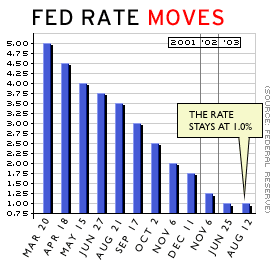NEW YORK (CNN/Money) -
The Federal Reserve left its key short-term interest rate unchanged Tuesday, and central bank policy makers said they still were concerned about a drop in inflation, though they saw signs of strength in the U.S. economy.
| 
| |

| 
| 
|

|
 The Federal Reserve left its key short-term interest rate unchanged at 1 percent. CNNfn's Susan Lisovicz reports. The Federal Reserve left its key short-term interest rate unchanged at 1 percent. CNNfn's Susan Lisovicz reports.
|
 Play video
Play video
(Real or Windows Media)
|
| 
|

|
|
The Fed's policy-makers, the Federal Open Market Committee (FOMC), left its federal funds rate, an overnight bank lending rate that often forms the basis of bank prime lending rates, at 1 percent. At its last policy meeting, in late June, the FOMC cut the fed funds rate by a quarter percentage point.
In the statement accompanying its decision, closely watched by financial market participants for clues about the future of Fed policy, the Fed said it expects economic growth to strengthen in the near future, but it was worried about a dangerous "unwelcome fall" in already-low inflation.
"The Committee judges that, on balance, the risk of inflation becoming undesirably low is likely to be the predominant concern for the foreseeable future," the statement said. "In these circumstances, the Committee believes that policy accommodation can be maintained for a considerable period."

Echoing recent economic data, the Fed said it saw signs that businesses were increasing their spending, but news on the labor market was still "mixed." Labor-market pain has continued for more than two years, though the latest recession ended in 2001.
The Fed's action was widely expected, and U.S. stock prices had little reaction to it. Stocks continued to trade higher, while Treasury bond prices were mixed, with long-term Treasurys selling off.
The Fed's deflation dread
The Fed cuts rates to lower the cost of borrowing, pumping more money into the economy when it thinks activity is too slow. When inflation is a risk, the Fed raises rates.
The Fed has cut rates 13 times since the start of 2001, helping to fight off the effects of a recession, terrorist attacks, corporate scandals, war and more.
| Related stories
|

|
|
|
|
Most economists -- including Fed Chairman Alan Greenspan -- believe the economy will strengthen in the second half of the year. But some Fed officials have expressed concern that the economy might not grow fast enough to cause inflation to rise.
Though the Fed spent decades battling inflation, and falling prices are certainly good in the short run for consumers, further falling inflation -- or "disinflation," in Fed-speak -- could help set the stage for the nasty economic condition known as deflation.
Japan, the world's second-largest economy, has battled deflation for much of the past decade, with little success. Deflation is an unstoppable drop in prices that hurts corporate profits, leading to more layoffs, which saps demand, hurting prices even further. It's a grim scenario the Fed has said it will do everything in its power to avoid.
"The Fed is fully aware that a slowly recovering economy needs to be nursed carefully back to health before the doctor sends the patient home," said Anthony Chan, chief economist at Banc One Investment Advisors.
Time for clarity?
Though the fed funds rate is at its lowest level since 1958, longer-term interest rates have risen recently, spurred by a selloff in the bond market, anticipating that the economy is poised for a rebound and that the Fed will have to raise interest rates soon to fend off inflation.
The Fed has tried to indicate it will keep rates lower for longer than usual in an environment where inflation and the labor market are slow to recover.
But the Fed has lost some of its credibility with bond markets, after raising and then dashing expectations for more-aggressive bond-buying and rate-cutting, leading to wild swings up and then down for bond prices.
"In crafting today's FOMC statement, we believe Fed officials were undoubtedly influenced by the perception that mixed signals from the Fed, and possibly some loss of credibility, accounted for some of the recent surge in bond yields," said UBS Warburg chief economist Maury Harris.
The volatility has led many analysts to call for the Fed to be more specific about its goals for inflation, to eliminate much of the guesswork in handicapping Fed policy. But most Fed officials, including Chairman Greenspan, would prefer not to engage in so-called "inflation targeting," and Tuesday's statement was only subtly different from June's statement.
"Today's FOMC statement did not add any new specificity or much elaboration, and the initial reaction in the bond market has been limited," Harris said.

|

